Promote an Active Workforce with Standing Desks
Standing desks and other innovative workstations can help counterbalance the negative health effects of sitting.
Introduction
The cardboard box that Jason McCann’s colleague used to create a standing desk in 2012 was a bit ahead of its time. McCann’s co-worker wanted to stay in an upright position to ease his sciatic nerve pain but couldn’t find a desk to serve that purpose, so he put a box on his desk and stuck his computer on top of it.
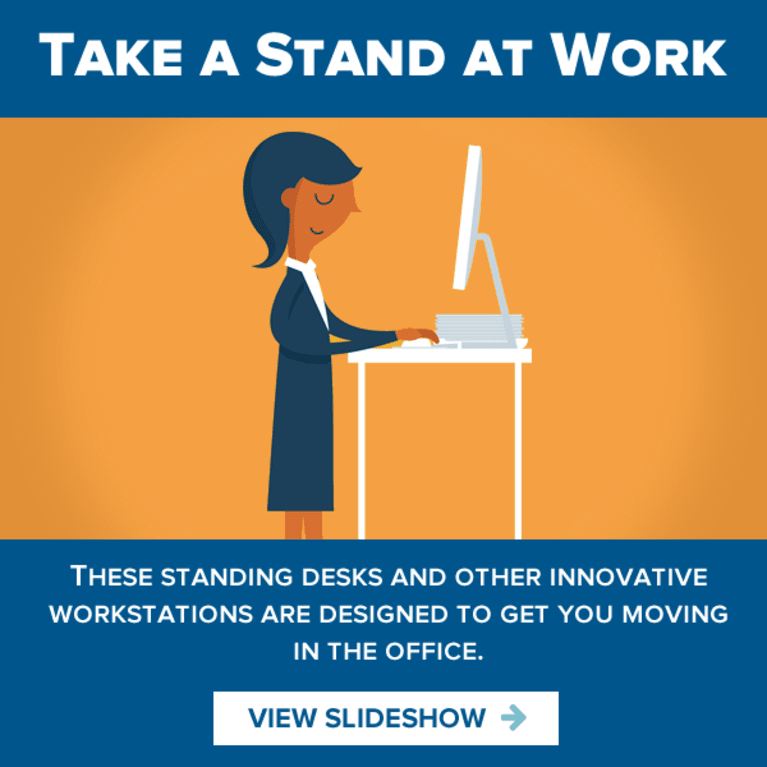
This makeshift furniture gave McCann and his co-worker a business idea: to create and sell workstations that sit atop regular desks but that can pop up to create a work surface at standing height when employees want to switch positions. That’s how the Coppell, Texas-based startup Varidesk came to be.
A few years later, the standing desk market is booming, as both supply and demand have jumped for office furniture that gets people out of their seats.
That’s due in part to a growing body of medical research showing that sitting all day at work—something millions of people do—can be bad for workers’ health.
Hazards include increased risks of heart disease and other cardiovascular problems, diabetes, and impaired cognitive ability. And that’s hardly all. There are 34 chronic diseases linked to sedentary behavior, says James Levine, an endocrinologist who is director of obesity solutions for Mayo Clinic and Arizona State University in Phoenix.
“We were not designed to sit all day. We were designed to move,” says Lucas Carr, an assistant professor of health and human physiology at the University of Iowa. “This is causing people to live shorter lives. It’s a risk factor, just like smoking.”
Even those who exercise outside the office can face negative health consequences if they are “desk potatoes” by day, according to recent studies. For example, the American Heart Association released an article in the journal Circulation last August indicating that Americans sit six to eight hours a day on average—and that exercise can only partially offset the effects of prolonged sedentariness on a range of cardiovascular conditions. The group pointed to “activity-permissive” workstations as one strategy for curbing risk by reducing sitting time.
Just as the public is getting wise to the health dangers of sitting, manufacturers are capitalizing on the business opportunity.
And it’s no wonder that the issue has stimulated employer interest. Wellness specialists agree that getting workers to be more active can increase concentration and productivity, promote healthy habits, reduce sick days, improve employee morale, and boost recruiting, since many good workers are attracted to healthy offices. It can also cut health care costs by reducing injuries like those to the neck, wrist, elbow and back.
“It’s highly cost-effective,” says Alan Hedge, director of the Human Factors and Ergonomics Research Laboratory at Cornell University.
In fact, the return on investment is typically between $3 and $7 for every $1 invested in workplace interventions that help people be more active on the job, according to Levine.
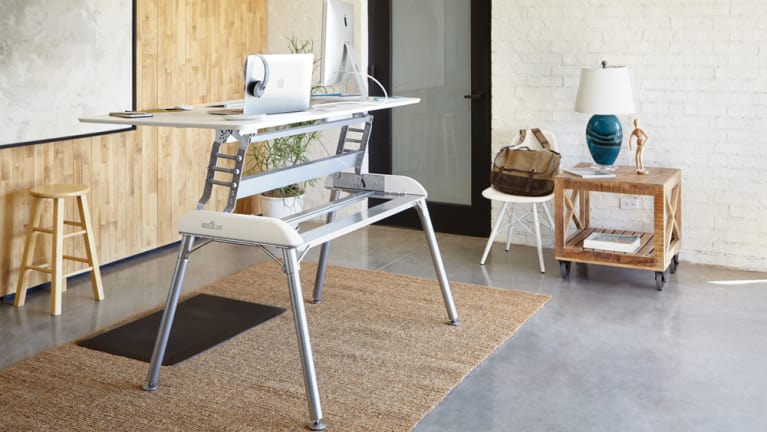
A Burgeoning Market
In addition to standing-only desks and desks that transform between sitting and standing, there is an array of other office furniture that promotes activity, including workstations with treadmills or bicycles attached, inflatable balls used as desk chairs, and under-desk elliptical machines.
These innovative products may represent a revolution of sorts. “The office in 10 years will have more activity inherent in it than it does right now,” says Peter Schenk, president of Salt Lake City-based LifeSpan, which makes treadmill desks and bike desks.
Researchers are still trying to figure out the maximum period that people can sit without incurring any increased health risks, but two hours straight is probably too lengthy, says Carr, who studies the cardiovascular effects of prolonged sitting.
Being seated even for an hour raises the chance of blood clots, Hedge says. Sedentariness causes individuals to pack on pounds because it signals the body to store calories as fat instead of burning them off. It also reduces the impact of gravity—in other words, the body doesn’t have to expend energy to carry its own weight—so people lose bone and muscle density and get weaker (much like astronauts do). And it causes compression of the lower spine, which can lead to back problems, especially when workers lean forward toward a computer.
All of these effects prompt companies to ask: “Is it OK to require [workers] to sit there all day for a number of years?” Carr says.
A growing number of business leaders don’t think so. While many of the first so-called active workstations were bought by individuals who didn’t want to sit all day, now corporations are buying them in bulk.
[SHRM members-only resource: Discuss this article on SHRM Connect]
The sit/stand desks that Zillow Group bought for all of its approximately 2,600 workers in 2014 and the treadmills it placed on every floor have helped reduce stress and have made the company more appealing to workers and prospective employees, says Dan Spaulding, vice president of people and culture at the online real estate database company in Seattle.
“If you’re not considering it, you’re going to put yourself at a competitive disadvantage,” Spaulding says. “Employees don’t want to just sit all day.”
Spaulding is a triathlete who runs several miles before work but still believes that his sit/stand desk is a huge benefit to his health. (He has used one at three previous employers, including Starbucks, as well.) He tends to flip the switch to raise his desk to standing in the afternoons when he otherwise would be restless.
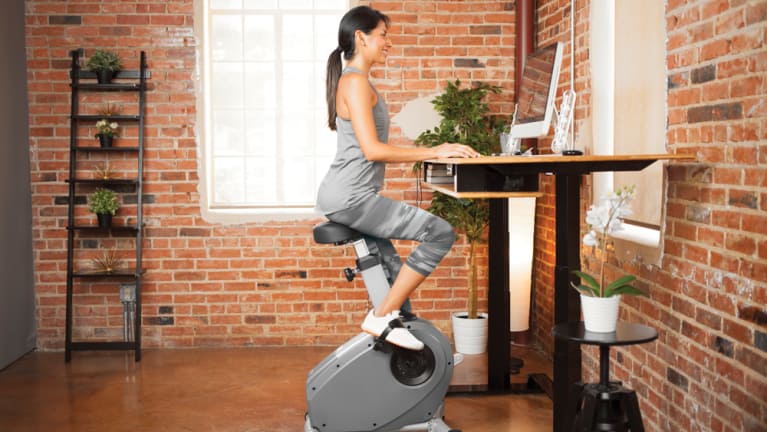
Costs Vary
Full sit/stand desks are, of course, more expensive. Prices at Steelcase Inc. in Grand Rapids, Mich., are between about $1,000 and $5,000. The company’s best-seller, Ology, has a list price of more than $2,000, though bulk discounts are available.
LifeSpan’s treadmill desks cost up to $2,000, and bike desks are typically $1,000 or more.
But prices and options for active workstations have been improving, according to Tim State, enterprise vice president of associate health and well-being at Humana. The Louisville, Ky.-based health insurance company has 55,000 employees and offers treadmill desks in 43 of its 52 larger facilities. So far, 10 of the locations have sit/stand desks, which are a growing part of the company’s design principle. (Employees can request the desks after undergoing an ergonomic assessment.) The company also offers spaces where people can stand and work collaboratively. “The idea is movement in the workplace and making that easy and attractive,” State says.
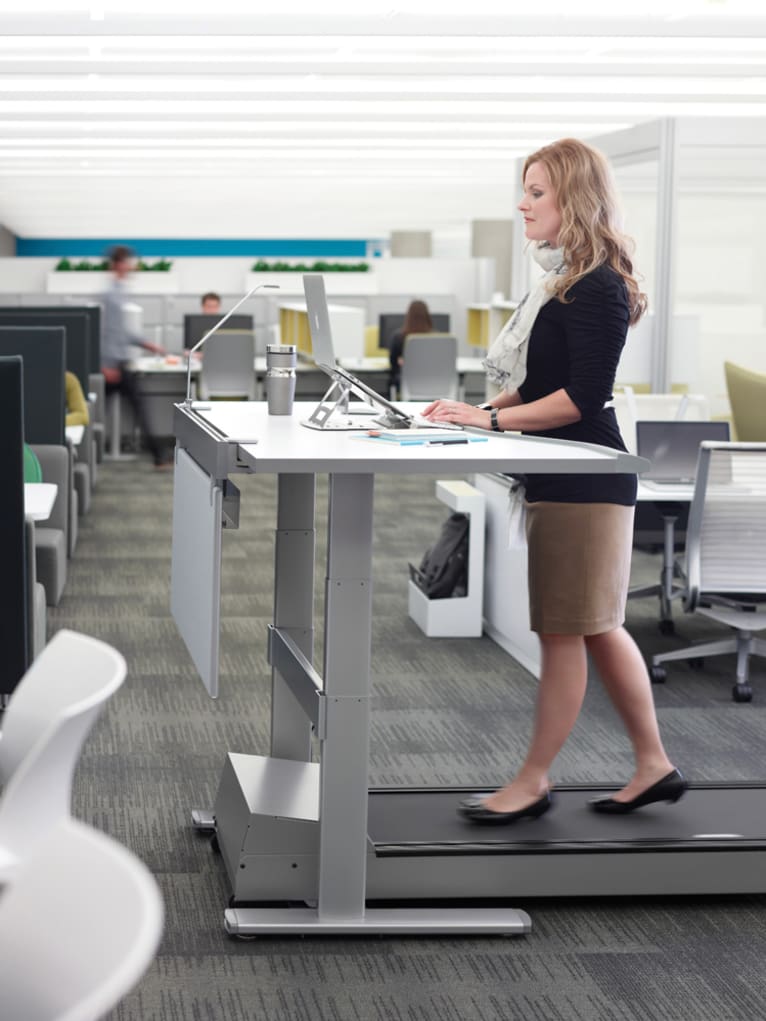 Humana introduced the sit/stand desks eight years ago and the treadmill stations in 2010. It has also pushed other health initiatives, which makes it hard to separate out the impact of active workstations alone. But employee engagement scores are up and retention has been boosted by the company’s commitment to workers’ well-being, State says. And employee health risks for chronic conditions have dropped 42 percent since 2012, as measured by metrics like blood pressure, glucose levels and body mass index.
Humana introduced the sit/stand desks eight years ago and the treadmill stations in 2010. It has also pushed other health initiatives, which makes it hard to separate out the impact of active workstations alone. But employee engagement scores are up and retention has been boosted by the company’s commitment to workers’ well-being, State says. And employee health risks for chronic conditions have dropped 42 percent since 2012, as measured by metrics like blood pressure, glucose levels and body mass index.
Zillow Group has seen improvements, too. Health claims have fallen in the two years since it introduced its sit/stand desks, and employee engagement scores have gone up.
“Is it directly related to standing desks? No. But we view it as part of our ecosystem of health and wellness,” Spaulding says. “It’s a no-brainer.”
Employees should be able to move between different postures during the day, says Ken Tameling, general manager of furniture and applications at Steelcase. (McCann’s research shows that people with desks that let them stand while working remain upright four to six hours a day on average.) “The key is to keep moving,” Tameling says. That’s not easy considering 86 percent of employees at organizations around the world who were surveyed by Steelcase reported that they still have landlines and 80 percent have desktop computers—devices that keep them tethered to their desks.
Getting Started
So how can HR departments change over to active workstations? No employer wants to spend big money only to find its treadmill desks sitting idle a few months later.
Education is the first step. Teach employees to listen to their bodies: “If you start to feel fidgety, get up,” Carr says.
Humana has been educating employees for several years about the risks of a lack of physical activity and the importance of a healthy lifestyle. So when it introduced active workstations, they fit the culture, State says.
Tell people to do what feels comfortable, Spaulding advises: “Sitting and standing are two of the most natural things we do as humans. In the grand spectrum of changes I’ve seen in the workplace, this is one of the easiest.”
The optimal mix of activities is to sit for 20 minutes, stand for eight and move (walk or stretch) for two, according to research from Cornell’s Hedge. “We want people to mix up their day from sitting to standing to moving,” he says. Researchers have found less fatigue in workers who change their position during the day.
Also think about how to deploy different types of workstations. Treadmills, for instance, are difficult to use while typing or maneuvering a computer mouse and can increase error rates, Hedge says, but are good for phone calls, reading and watching videos. Walking brings more oxygen to the brain, he adds, so frequent short strolls can boost productivity. And users like Tameling at Steelcase say treadmills help them avoid the post-lunch “food coma.”
Instead of providing treadmill desks to individuals, many companies place a few on each floor or in each department so that employees can use them as a break from their own sitting or standing desks. While sit/stand desks are standard size, the treadmills take up more space. Research shows that people who have desks that enable them to stand don’t end up standing all day, Levine says, but they do end up moving one to two hours a day more. “Once you’re off your bottom, you’re more likely to walk,” he says.
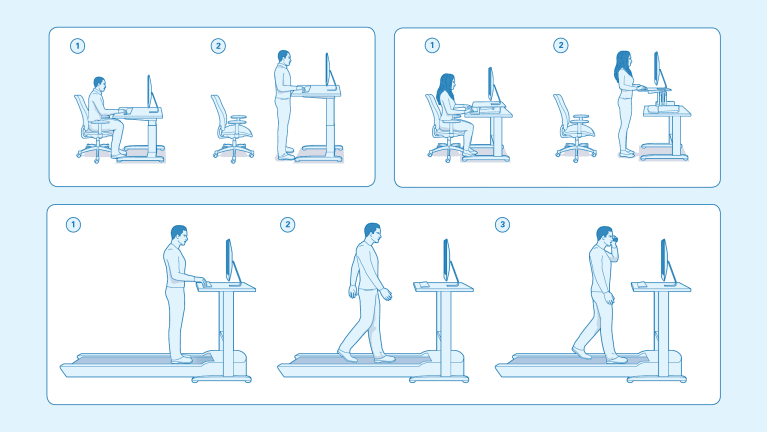
Part of the Culture
Innovative furniture alone isn’t a silver-bullet solution to the risks of sedentariness. “It takes leadership, commitment, a reflection in values and embedding in the culture,” State says.
Start by looking at your company’s own culture, resources, workforce age and other factors, Levine says. Walking meetings are a great option for many offices and are free (with an extra bonus of lasting 11 minutes less, on average). But they might not work, say, at a law firm with confidentiality considerations.
“Buying equipment is not the answer to your employees’ health problems,” Levine says. “The answer is a deep level of engagement across the corporate infrastructure to bring health to every single individual. The answer is to give health options facilitated by furniture, lighting, good food, supportive management and an encouraging culture.”
Not every worker will react the same to the addition of active workstations. Levine does consulting work for companies and has seen it all, from the guy who bragged about walking a half marathon at his workstation to the treadmill desk still wrapped in plastic months after delivery. Treadmill desks tend to be either in high demand or not used at all, he says. A big factor that influences what will happen at a given company is whether managers use the workstations and encourage activity in the workplace. Without that leadership, employees worry that time on the treadmill—even at 1 mph while working—will be seen as exercising instead of working.
‘Buying equipment is not the answer to your employees’ health problems. The answer is a deep level of engagement across the corporate infrastructure to bring health to every single individual.’
—James Levine, Mayo Clinic and Arizona State University
So if you opt for active workstations, it’s important to emphasize that you want people to use them. “If there are six people and only one is standing, they kind of look like a prairie dog,” Tameling says. “If it happens in a silo, you’re more at risk of these investments not paying off.” Helping people achieve lifelong well-being is a stated goal of Steelcase, so “this is close to the heart of our purpose as an enterprise,” he explains. The company has found that when workers are encouraged to keep moving in the workplace, they maintain a higher level of activity that carries over outside the office.
Humana’s State uses a treadmill desk during part of the day and even forgets he’s walking. He holds meetings in areas set up for standing collaboration. And he takes the stairs, where inspirational signs like “stairway to health” are now placed.
“When you’re looking for the stairwell in a building, you know a switch has been flipped,” says State, who finds that he even does so outside of work and on the weekends. There’s a downside to that, though, he admits: “It doesn’t always go over well with my family.”
Tamara Lytle is a freelance writer in the Washington, D.C., area.
Illustrations by Jason Pickersgill for HR Magazine.
Was this article useful? SHRM offers thousands of tools, templates and other exclusive member benefits, including compliance updates, sample policies, HR expert advice, education discounts, a growing online member community and much more. Join/Renew Now and let SHRM help you work smarter.


